Types Of Woodpeckers in Virginia: A Comprehensive Guide to the 8 Different Species
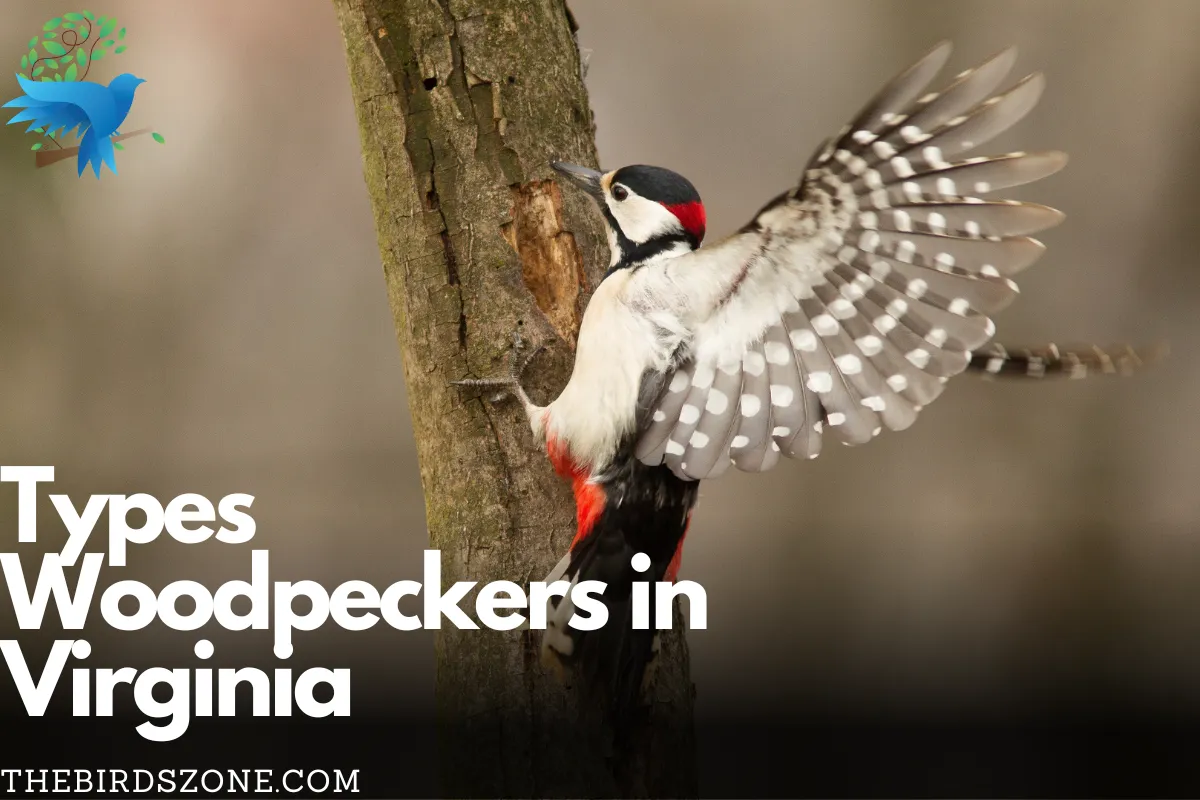
If you’ve ever gone for a walk in a forest or even just heard some hammering sounds outside your window, chances are you’ve encountered woodpeckers.
These unique birds are known for their ability to drum on trees with their beaks and create holes that serve as homes for themselves and other animals.
Virginia is home to several species of woodpeckers, each with its own distinct characteristics and behaviours.
There are 8 types of Woodpeckers In Virginia. These are . Red-cockaded Woodpeckers, Hairy Woodpeckers, Downy Woodpeckers, Northern Flickers, Pileated Woodpeckers, Red-headed Woodpeckers, and Red-bellied Woodpeckers, Yellow-bellied Sapsuckers.
Seven of Virginia’s eight woodpecker species can be found all year. Yellow-bellied Sapsuckers are the only species that do not breed in Virginia.
In this blog post, we’ll explore eight different types of woodpeckers found in Virginia, their habitat preferences, physical features, typical behaviours, and how to identify them.
From the large pileated woodpecker to the small downy woodpecker or even colorful red-headed one there’s always something new to discover.
So next time you’re on a hike or just sitting in your backyard, keep an eye (and ear) out for these incredible birds – they’re sure to amaze and captivate you.
Table of Contents
Pileated Woodpecker
Dryocopus pileatus
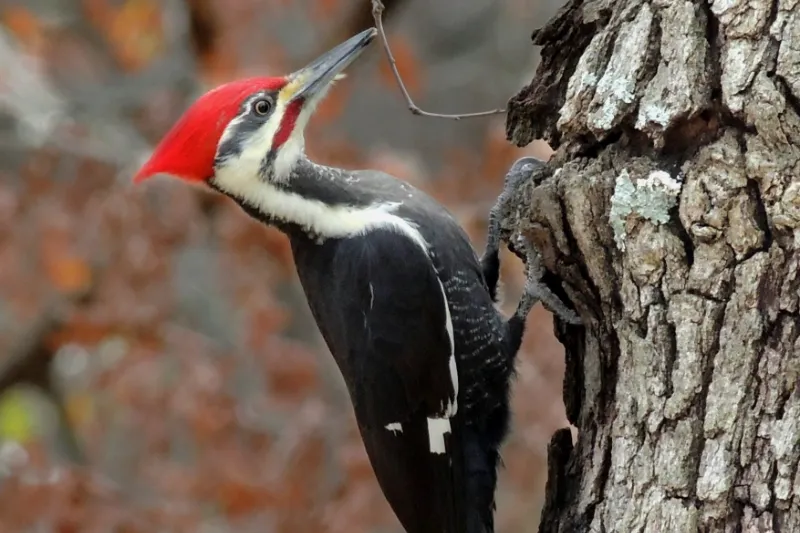
Length: 40cm to 49cm ( 15 inches to 19 inches)
Wingspan: 66cm to 75cm ( 26 inches to 29 inches)
Weight: 8.8 – 12.3 oz
Overview
The pileated woodpecker is one of the largest species of woodpeckers found in North America. They can grow up to 19 inches long with a wingspan of almost 30 inches.
Their black bodies are accented by vibrant red crests on top of their heads. Pileated woodpeckers prefer mature forests with tall trees where they can build large nests made out of bark chips.
How to identify Pileated Woodpecker?
To locate these birds in the wild, listen for their loud drumming calls that sound like “wuk wuk wuk”. You might also see rectangular-shaped holes on tree trunks that they use in search of carpenter ants and insects.
Pileated Woodpecker sound
Red-cockaded Woodpecker
Dryobates borealis
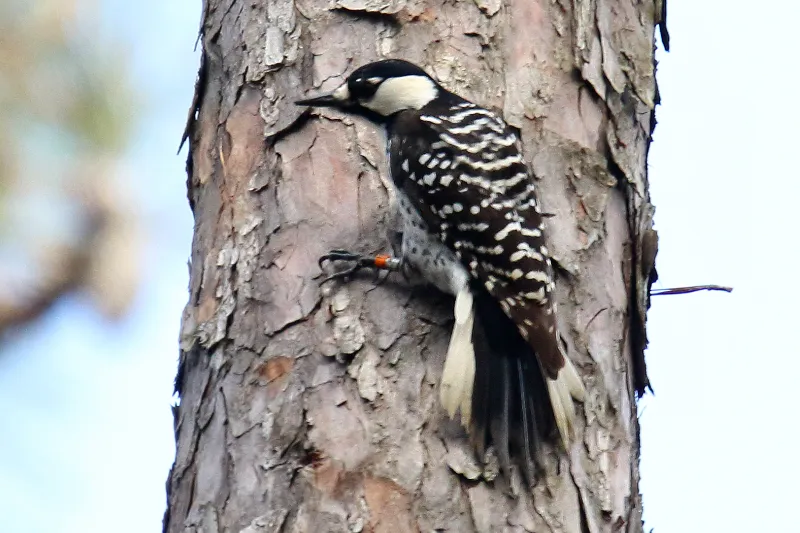
Length: 20 cm to 23 cm ( 7 inches to 9 inches)
Wingspan: 35 cm to 38 cm ( 13.7 inches to 15 inches)
Weight: 1.5 – 1.8 oz
Overview
The red-cockaded woodpecker is considered an endangered species due to loss of habitat from logging and urbanization. In 1970, this species was added to the endangered species list.
These small-sized birds have black-and-white striped backs and white cheeks with small red spots near their eyes (hence the name).
They prefer pine forests where they excavate cavities high up on live pine trees – usually around 20 feet off the ground.
How to identify Red-cockaded Woodpecker?
To identify them in the wild look for clusters or groups (called clans) that consist of either one breeding pair or multiple non-breeding males guarding nesting cavities against predators such as snakes and flying squirrels.
These woodpeckers have brown bars all over their wings and tails, as well as incredible black and white facial patterns. These are mostly found in pine trees.
Red-cockaded Woodpecker Sound
Yellow-bellied Sapsucker
Sphyrapicus varius
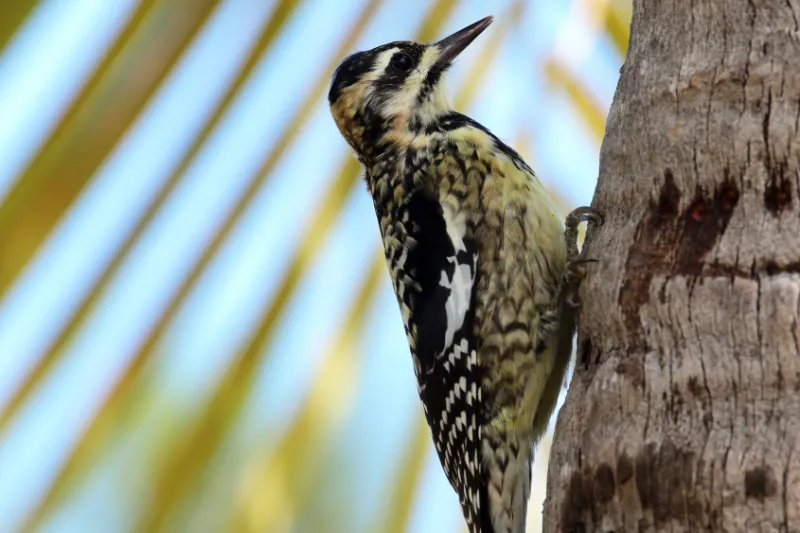
Length: 22 cm ( 7.1 inches to 8.7 inches)
Wingspan: 34 cm to 40 cm ( 13.4 inches to 15.8 inches)
Weight: 1.5 – 1.9 oz
Overview
As its name suggests, the yellow-bellied sapsucker feeds on tree sap by drilling small holes in rows around a trunk or branch of a tree.
They are medium-sized woodpeckers with black-and-white striped heads and greyish bellies. Some individuals have red foreheads.
How to identify Yellow-bellied Sapsucker?
They prefer mixed forests that contain both coniferous and deciduous trees.They can find their preferred food source -tree sap- during winter months when insects aren’t available.
They are mostly found in northern territories of Canada.
To locate them in the wild, listen for their calls which sound like “mew mew”. Best to identify these birds is to look for neat rows of small holes on trunks that line up horizontally.
Northern Flicker
Colaptes auratus
Length: 28 cm to 31 cm ( 11 inches to 12.5 inches)
Wingspan: 50 cm to 55 cm ( 20 inches to 22 inches)
Weight: 3.9 – 5.6 oz
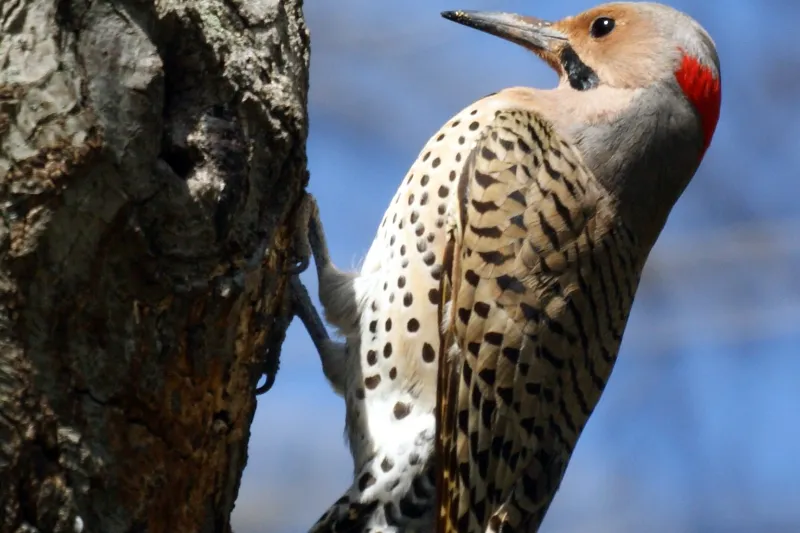
Overview
The northern flicker is another large species of woodpecker found in Virginia but instead of being black it has brown plumage with black spots on its back.
The male has a distinct red patch at the nape whereas females don’t have one). These birds also feed mainly on insects but supplement their diet with berries and seeds especially during fall migration periods.
They prefer open areas such as fields, pastures, parks, or even suburban yards where there is access to soil which allows them to dig burrows for nesting sites.
How to identify Northern Flicker?
To identify them you may see them perched vertically against tree trunks (unlike many other woodpeckers). If they do perch on trees, it is usually on the upright branches rather than the trunk side. Northern Flickers rarely use feeders.
Northern Flicker Sound
Downy Woodpecker
Dryobates pubescens
Length: 14.5 cm to 17 cm ( 5.7 inches to 6.6 inches)
Wingspan: 25 cm to 30 cm ( 9.8 inches to 11.8 inches)
Weight: 0.7 – 1.0 oz
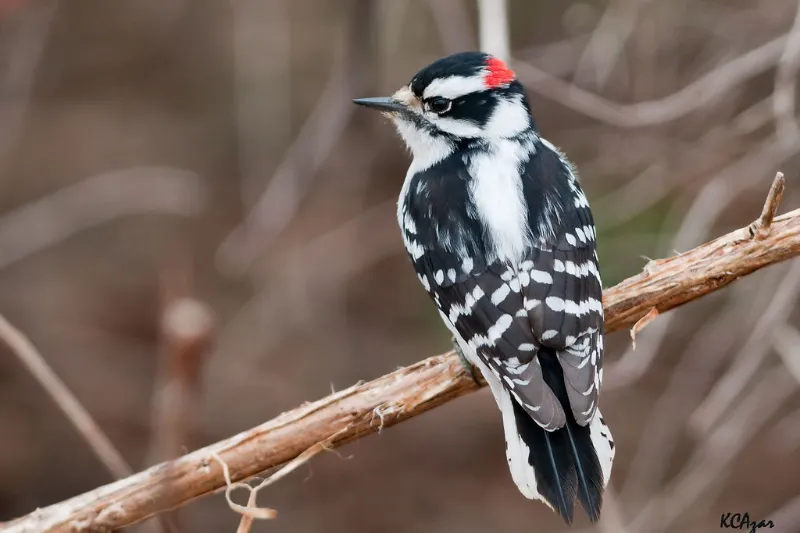
Overview
The downy woodpecker is one of the smallest species found in Virginia. Their length is average of only 6 inches long.
This bird’s feather pattern consists of white-striped black wings combined with checkered-black-and-white backsides together with white belly patches. The males sport bright red nape feathers while female ones lack this marking.
Their habitat preferences include any wooded area from mature forests to urban parks including backyard birdfeeders where they consume suet, nuts and sunflower seeds.
How to Identify Downy Woodpeckers?
Downy Woodpeckers are identifiable by their black and white coloring, and males downy woodpecker have a red patch on their heads. To identify them look for their high-pitched “pik” sounds which can be heard year-round.
Downy Woodpecker Sound
Hairy Woodpecker
Dryobates villosus
Length: 25 cm to 30 cm ( 9.8 inches to 11.8 inches)
Wingspan: 38 cm (15 inches)
Weight: 1.4 – 3.4 oz
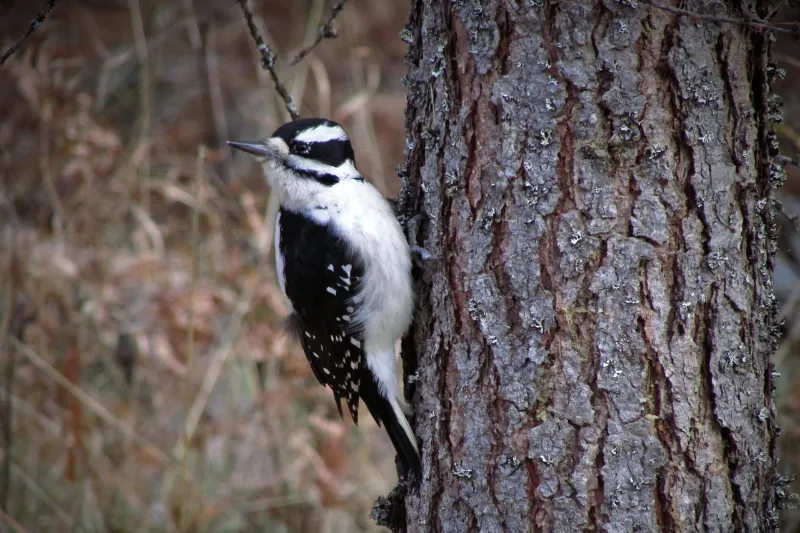
Overview
The hairy woodpecker is slightly larger than the downy with a length of 9-10 inches.
They have a black back with white undersides, but unlike the downy, they lack any red plumage on their heads or necks.
They prefer mature forests where they feed primarily on insects found under bark or in crevices in trees from Northern Coniferous to hardwood stands.
How to identify Hairy Woodpecker?
To spot them listen for their unique drumming sound (often slower and more deliberate than other species) that echoes through the woods.
The Hairy Woodpecker resembles the Downy Woodpecker in size, with striking black and white checkered feathers and a huge white patch on its back. Males have a red spot on the back of their heads.
Hairy Woodpecker Sound
Red-bellied Woodpecker
Red-bellied Woodpecker
Length: 26 cm (10 inches)
Wingspan: 33 cm to 41 cm ( 13 inches to 16.5 inches)
Weight: 2.0 – 3.2 oz
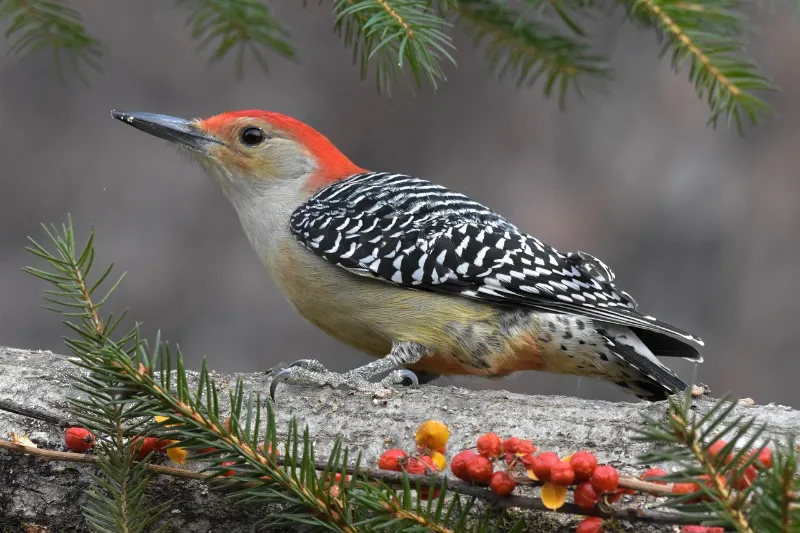
Overview
Despite its name, the red-bellied woodpecker actually has only a hint of reddish tint on its belly feathers.
These medium-sized birds have bright red caps and napes which make it easy to distinguish them from other species. Their backs are mostly black-and-white striped while their bellies tend to be grayish.
Their preferred habitat includes mixed forests especially ones with oak stands where they feed on acorns as well as various insects found under bark.
How to identify Red-bellied Woodpecker?
This bird has been known to store food items such as nuts inside tree holes so watch out for these clues when trying to locate one.
Red-bellied Woodpecker Sound
Red-headed Woodpecker
Melanerpes erythrocephalus
Length: 19.4 cm to 23.5 cm ( 7 inches to 9.25 inches)
Wingspan: 33 cm to 37 cm ( 13 inches to 14.5 inches)
Weight: 2.0-3.2 oz
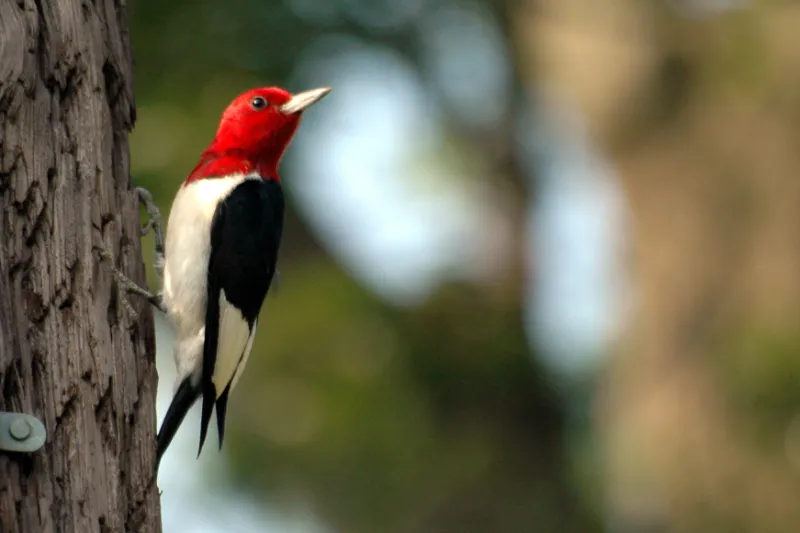
Overview
Last but not least we come across another colorful member: The Red-headed woodpeckers.
These striking birds boast entirely crimson-red heads together with contrasting pure white bellies and jet-black wings. They’re also relatively small compared to others at around 7-9 inches long.
They prefer open woodland areas like savannahs or fields where there are scattered trees plus wide gaps between vegetation allowing then easier access during aerial pursuits of flying insects.
How to identify Red-headed Woodpecker?
To identify this particular type of woodpecker look out for their unmistakable “churr” call followed by fast wing-beats overhead.
Red-headed Woodpecker Sound
Read More: Why Do Woodpeckers Peck Wood? 3 Fascinating Reason >>>
Read More: Are Blue Jays Aggressive Birds? Truth About Their Aggression



